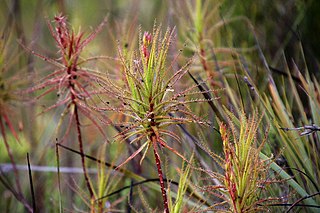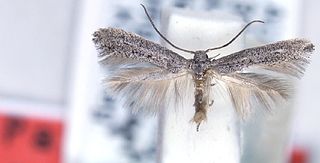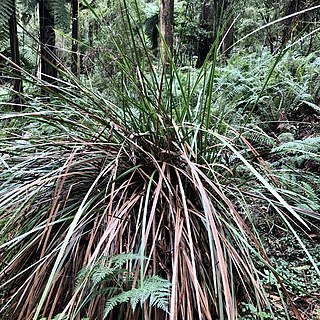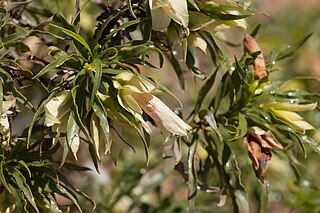
Roridula is a genus of evergreen, insect-trapping shrubs, with two species, of about 1⅓–2 m. It is the only genus in the family Roridulaceae. It has thin, woody, shyly branching, upright, initially brown, later grey stems, with lance- to awl-shaped leaves crowded at their tips. The star-symmetrical flowers consist from the outside in of five, green or reddish, free sepals, alternating with five white, pink or purple, free petals. Further to the middle and opposite the sepals are five stamens with the anthers initially kinked down. These suddenly flip up if the nectar-containing swelling at its base is being touched. The center of the flower is occupied by a superior ovary. The leaves and sepals carry many sticky tentacles of different sizes, that trap insects. Roridula does not break down the insect proteins, but bugs of the genus Pameridea prey on the trapped insects. These later deposit their feces on the leaves, which take up nutrients from the droppings. The species can be found in the Western Cape province of South Africa. They are commonly known as dewstick or fly bush in English and vlieëbos or vlieëbossie in Afrikaans.

Pittosporum is a genus of about 200 species of flowering plants in the family Pittosporaceae. The genus is probably Gondwanan in origin; its present range extends from Australasia, Oceania, eastern Asia and some parts of Africa. Citriobatus can be included here, but might be a distinct genus. They are commonly known as pittosporums or, more ambiguously, cheesewoods.

Callitris endlicheri, commonly known as the black cypress pine, is a species of conifer in the family Cupressaceae. It is found only in Australia, occurring in Queensland, New South Wales, the Australian Capital Territory, and Victoria.

Roridula dentata is a protocarnivorous plant native to the Western Cape province of South Africa.

Roridula gorgonias is an evergreen, shyly branching, upright shrub of up to about 1 m (3 ft) high, from the family Roridulaceae. It has awl-shaped leaves with entire margins, crowded at the tip of the branches. These are set with tentacles that secrete a sticky, shiny resin from the thicker gland at their tips, that catch many airborne items. At the center of the shoots appear inflorescences between July and October that consist of up to twelve flowers in spikes, each on a short flower stalk, with a bract at its base. The 5-merous flower is about 2½ cm (1 in) in diameter and has pinkish purple or white petals. The plants do not digest the trapped insects, but the bug Pameridea roridulae sucks out their juices and the plant absorbs nutrients from the bug's droppings. It is therefore considered a protocarnivorous plant. It is called Gorgons dewstick, fly bush or fly catcher bush in English and vliebos, or vlieëbossie in Afrikaans.. R. gorgonias is an endemic species home to the southwest of the Western Cape province of South Africa.

Lepidosperma is a genus of flowering plant of the family Cyperaceae. Most of the species are endemic to Australia, with others native to southern China, southeast Asia, New Guinea, New Caledonia and New Zealand.

Arctostaphylos glutinosa is a species of manzanita known by the common name Schreiber's manzanita. It is endemic to Santa Cruz County, California, where it is known from only a few occurrences on the western slopes of the Santa Cruz Mountains. It grows in the chaparral of the limestone and diatomaceous shale ridges on the coastline.

Arctostaphylos regismontana is a species of manzanita known by the common name Kings Mountain manzanita. It is endemic to California, where it is known from the northern slopes of the Santa Cruz Mountains in the southern San Francisco Bay Area.

Arctostaphylos virgata is a species of manzanita known by the common names Bolinas manzanita and Marin manzanita.

Brickellia greenei is a species of flowering plant in the family Asteraceae known by the common name Greene's brickellbush. It is native to the mountain ranges of southwestern Oregon and northern California, including the Cascades, the northern Coast Ranges, and Sierra Nevada.

Hesperilla trimaculata, the three spot skipper, is a butterfly of the family Hesperiidae. It is found in Australia.

Lepidosperma urophorum, the rapier saw sedge is a forest dwelling plant found in south eastern Australia. Often found on sandy soils near streams. It may grow to 1.5 metres high.
Synemon magnifica, the magnificent sun-moth, is a moth in the Castniidae family. It is found in Australia, including New South Wales.

Elachista crenatella is a moth of the family Elachistidae. It is found in the Australian state of South Australia near Adelaide and on Kangaroo Island.

Bejaria racemosa, commonly known as tarflower, is a woody shrub with a fragrant flower found in the southeastern US states of Florida, Georgia, and Alabama. It grows on flatlands in groups. Insects become trapped on its flowers due to the sticky secretions found there.

Lepidosperma filiforme, also known as the common rapier-sedge, is a sedge that occurs in coastal regions of south-eastern Australia and New Zealand. Plants grow to between 0.3 and 1 metre high. The culms are smooth, rigid, terete and between 0.7 and 2 mm in diameter. The leaves are also terete and about 1 mm in diameter, with sheaths that are straw coloured or reddish.

Lepidosperma elatius is a species of plant from the sedge family that can be found in Australia. The plant grows to a height of 1–2.5 metres, with leaves 5–15 millimetres (0.20–0.59 in) in width, and which are convex on both sides, with sharp margins. The spikelets have a drooping spray with a length of 18–65 centimetres (7.1–25.6 in). The plant flowers from November to April.

Eremophila alatisepala is a plant in the figwort family, Scrophulariaceae and is endemic to the south-west of Queensland in Australia. It is a very sticky shrub covered with many glandular hairs which produce a resin that often obscures the hairs that produce it. The plant is usually found in stony places on ridges and slopes in the Queensland Channel Country.

Eremophila crenulata is a flowering plant in the figwort family, Scrophulariaceae and is endemic to the far west of Western Australia. It is a large shrub, distinguished by its broad leaves which have distinctively wavy margins. The flowers are white, pink or blue and occasionally purple.

Lepidosperma canescens is a sedge of the family Cyperaceae that is native to south-east South Australia and Victoria. There are no synonyms.




















